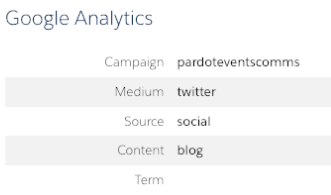Do you find it hard to identify entry points for your digital marketing campaigns? With UTM Parameters you can easily put the pieces of the puzzle together and impress your team.
What are UTM parameters?
UTM stands for Urchin Tracking Module, which is an out-of-the-box Google Analytics module.
With UTM tracking, you are able to track the effectiveness of your marketing campaigns through five unique parameters: medium, source, term, content and campaign.
See the below table with more details and examples:
| Parameter | Purpose | Examples |
| Medium* | Identify a medium such as email or cost-per-click. | paid social, referral, cpc |
| Source* | Identify a search engine, newsletter name, or other source. | twitter, [partner-name], google |
| Term | Used for paid search to note the keywords for that specific ad. | pardot consultancy |
| Content | Used for A/B testing and content-targeted ads to differentiate ads or links that point to the same URL. | Logolink or textlink |
| Campaign* | Identify a specific product promotion or strategic campaign. | summer_party_2021 |
* Parameters we recommend setting up all the time.
How do you capture the UTM parameters in Pardot?
In order to leverage this functionality, you need to configure the Google Analytics connector. Once that is in place, add the Google Analytics / Google Tag Manager tracking code to your Pardot layout templates. That will allow Pardot to capture the parameters upon the first touchpoint of prospects.

These parameters can be populated either via a URL, built using the Campaign URL Builder, or by applying them to any Pardot Custom Redirects.
Either way, when prospects are created through a tracked link, the UTM parameters will be displayed on their prospect record.
In addition, when the UTM source parameter is captured it will populate the Pardot source field on the prospect record. This provides additional value to your team, as this field is very popular in marketing / sales reports.
How to use them?
When your Pardot and Google Analytics accounts are connected, you can leverage the recorded UTM parameters in your Analytics dashboards. As an additional step, you can connect them to your Analytics events and goals to track conversions and ROI more accurately.
Since the data is recorded in Pardot, you can use it to identify prospects who were created through specific promotional campaigns. Therefore, you can include the parameters in your segmentation list, then target them with an optimised email campaign.

Pardot automatically syncs all UTM parameters to Salesforce as Google Analytics fields on the Lead and Contact Objects. This means your team can easily build a report in Salesforce that tracks the effectiveness of your Lead Generation campaigns.
***
One thing I would recommend is putting together a strategy for your team with clear instructions and examples. Ensure that they all know how these parameters are populated, and how they can benefit from using them.
But if you need help, get in touch with our team and we can help you spread the good word.
